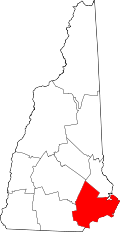History
First settled in 1639, the town was a part of Hampton known as "North Hill" or "North Parish". Residents began petitioning for separation from Hampton as early as 1719, but township was not granted until 1742 by colonial governor Benning Wentworth, following separation of New Hampshire from Massachusetts.
Little Boar's Head, a seaside promontory, became a fashionable summer resort area in the 19th century, and contains elegant examples of late Victorian and Edwardian architecture. [3]
Geography
North Hampton is in southeastern New Hampshire, bordered to the east by the Atlantic Ocean. It is bordered to the north by the towns of Greenland and Rye, to the west by Stratham, and to the south by Hampton. It touches the town of Exeter to the west at a single point.
According to the U.S. Census Bureau, North Hampton has a total area of 14.4 square miles (37.3 km2), of which 13.9 square miles (36.0 km2) are land and 0.50 square miles (1.3 km2) are water, comprising 3.46% of the town. [1] The highest point in North Hampton is the summit of Pine Hill, at 160 feet (49 m) above sea level, on the town's western border. The town is drained to the east by the Little River, which flows directly to the Atlantic Ocean, and to the northwest by the Winnicut River, which flows to Great Bay, which in turn reaches the Atlantic by way of the Piscataqua River through Portsmouth.
U.S. Route 1 and state routes 1A and 151 run north–south through North Hampton, while 111 runs east–west. Interstate 95 runs through North Hampton without access to the town; Route 101 provides easier freeway access to North Hampton despite never entering the town. The nearest commercial airport is Portsmouth International Airport; the two closest major airports are Logan Airport in Boston and Portland International Jetport in Maine.
Demographics
As of the census [5] of 2000, there were 4,259 people, 1,671 households, and 1,234 families residing in the town. The population density was 306.3 inhabitants per square mile (118.3/km2). There were 1,782 housing units at an average density of 128.1 per square mile (49.5/km2). The racial makeup of the town was 98.40% White, 0.31% African American, 0.05% Native American, 0.63% Asian, 0.21% from other races, and 0.40% from two or more races. Hispanic or Latino of any race were 0.77% of the population.
There were 1,671 households, out of which 29.8% had children under the age of 18 living with them, 64.6% were married couples living together, 7.0% had a female householder with no husband present, and 26.1% were non-families. 20.0% of all households were made up of individuals, and 8.3% had someone living alone who was 65 years of age or older. The average household size was 2.55 and the average family size was 2.96.
In the town, the population was spread out, with 23.3% under the age of 18, 4.4% from 18 to 24, 27.4% from 25 to 44, 30.5% from 45 to 64, and 14.3% who were 65 years of age or older. The median age was 42 years. For every 100 females, there were 95.3 males. For every 100 females age 18 and over, there were 94.3 males.
The median income for a household in the town was $66,696, and the median income for a family was $72,500. Males had a median income of $51,451 versus $31,512 for females. The per capita income for the town was $34,187. About 1.6% of families and 3.3% of the population were below the poverty line, including 0.7% of those under age 18 and 6.1% of those age 65 or over.
This page is based on this
Wikipedia article Text is available under the
CC BY-SA 4.0 license; additional terms may apply.
Images, videos and audio are available under their respective licenses.




